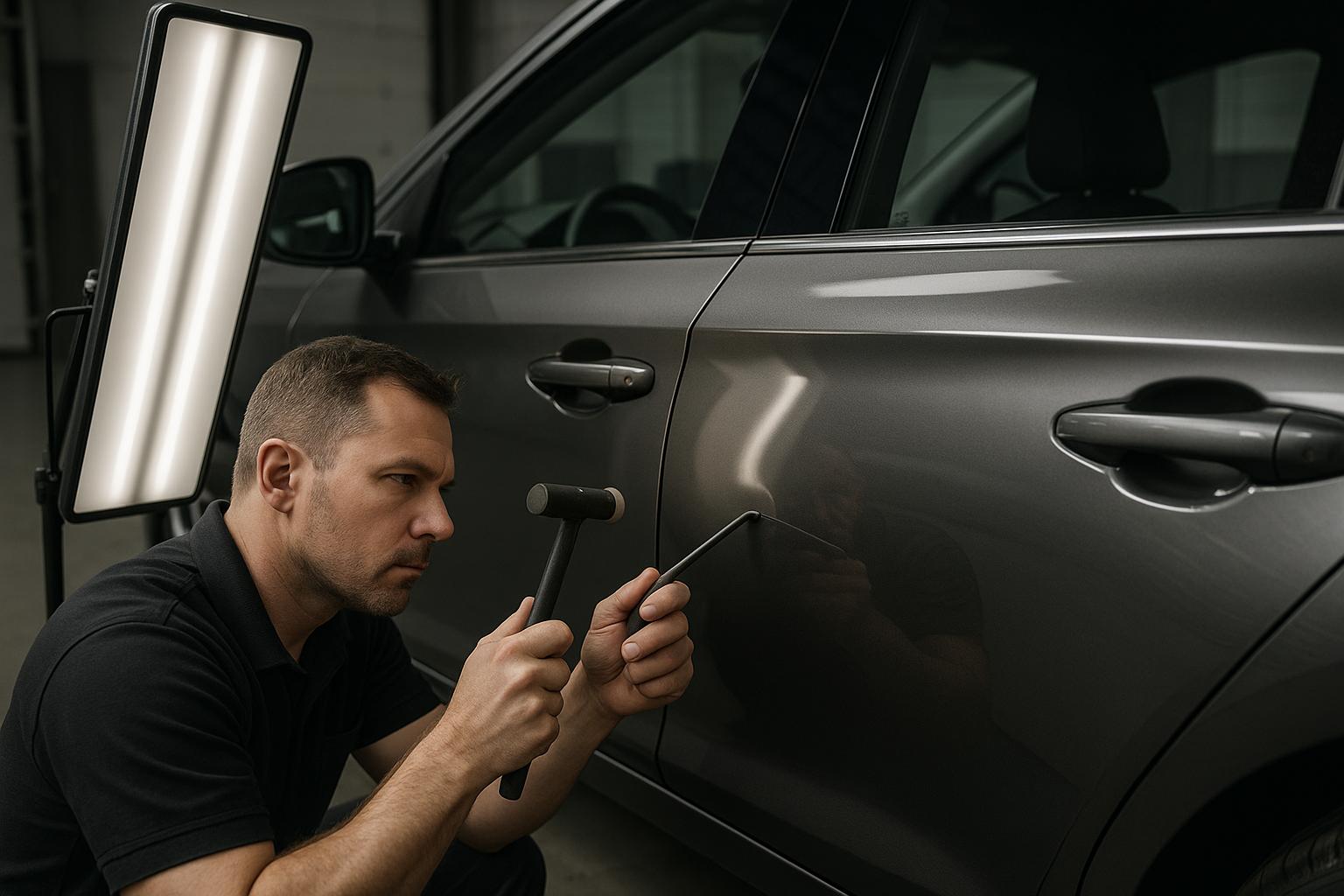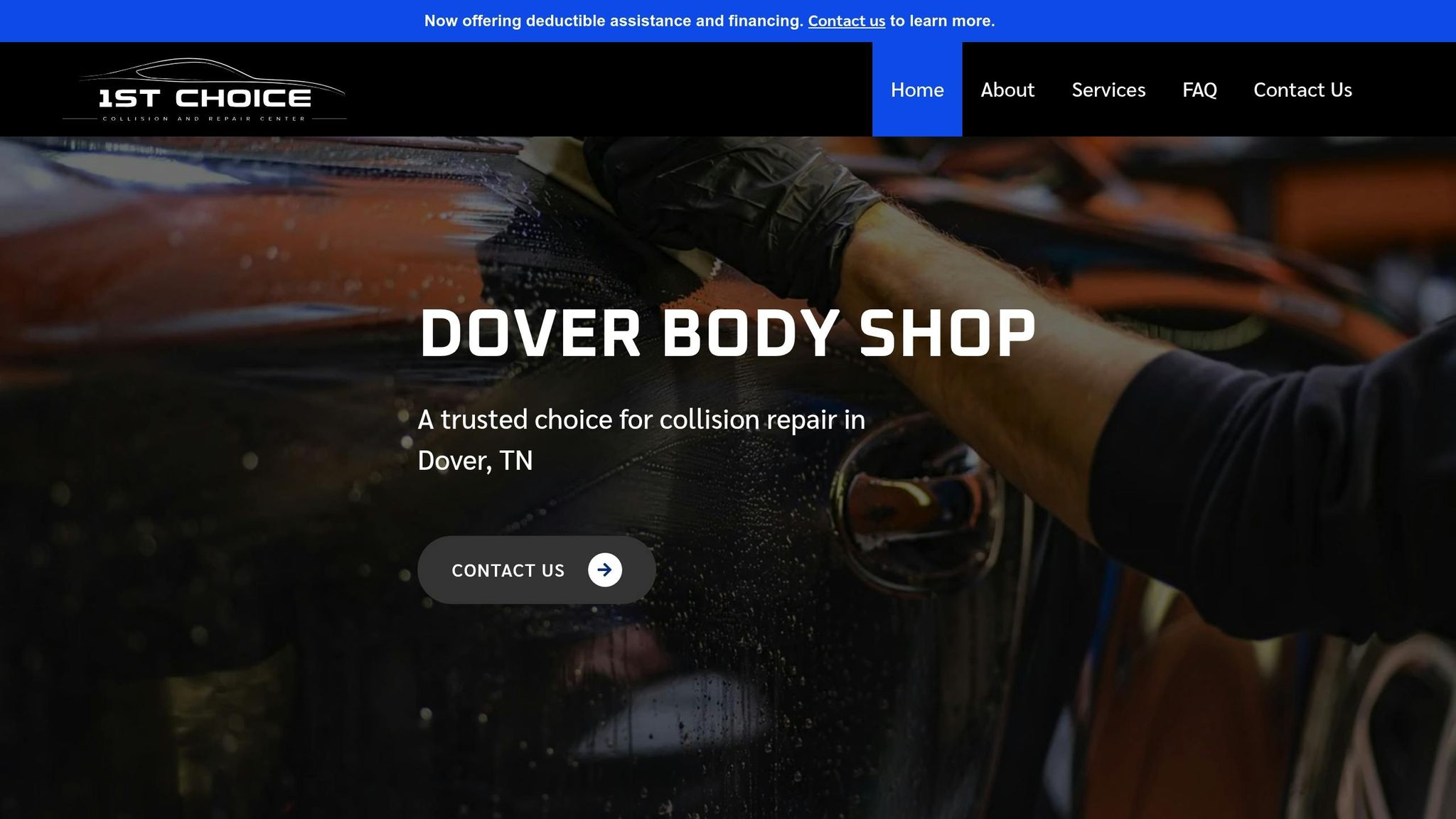August 17, 2025

Paintless Dent Repair (PDR) is a fast, cost-effective way to fix minor dents without sanding, fillers, or repainting. By reshaping the metal from behind, it preserves your car’s original paint and can often be completed in hours. Ideal for small dents where the paint is intact, PDR works best on steel panels but can be more challenging with aluminum. However, it’s not suitable for cracked paint, plastic parts, or large, deep dents.
If your car has minor dents and intact paint, PDR may be the right choice. Always consult a skilled technician to assess whether it’s the best option for your vehicle.
Understanding how Paintless Dent Repair (PDR) works can help you decide if it’s the right solution for your vehicle. At its core, PDR is based on a straightforward idea: metal has memory. When a metal panel on your car gets dented, it naturally wants to return to its original shape. Technicians leverage this property using specialized tools to gently guide the metal back into place.
The process starts with accessing the damaged area from behind the panel. Technicians use long, curved rods that are inserted through existing openings like door frames, windows, or by removing interior panels. By applying controlled pressure from behind, they gradually restore the panel's original shape.
Steel panels are particularly well-suited for PDR because steel naturally tries to revert to its original form. The technician works carefully, making small adjustments and frequently checking the progress to avoid overcorrecting or causing new imperfections.
Aluminum panels, on the other hand, don’t have the same memory as steel. They require more precise pressure and sometimes controlled heating to avoid cracking. These differences highlight the specific techniques needed for various materials.
For PDR to work effectively, several key conditions must be met. First and foremost, the paint on the damaged area must be completely intact - no cracks, chips, or flaking. If your car’s paint has aged and become brittle or if it has been repainted, PDR may not be a good option.
This method works best for minor to moderate dents on flat, accessible panels. Large, deep, or awkwardly positioned dents are often better suited for traditional repair methods. Additionally, areas near structural components or where multiple panels meet can be challenging for PDR and may require other approaches.
The location of the dent also plays a big role. Dents with sharp creases or those on complex curved surfaces are harder to fix, particularly on aluminum panels, which demand extra care and precision.
Now let’s talk about which surfaces are compatible with PDR. This technique works exclusively on metal panels, including both steel and aluminum.
When comparing steel and aluminum, there are some important differences. Steel’s natural tendency to return to its original shape makes it easier to work with during PDR. Aluminum, however, is more prone to cracking under pressure and requires specialized tools and techniques to handle properly.
Plastic components like bumpers or mirror casings cannot be repaired with PDR. Unlike metal, plastic doesn’t respond to these techniques because of its flexible and thin nature, which makes it harder to access dents from behind. Materials like fiberglass and certain composites also fall outside the scope of PDR.
The type of paint on your vehicle doesn’t usually affect PDR as long as the paint is in good condition. Whether your car has a standard finish, metallic paint, or a custom coating, PDR can be effective if the paint remains undamaged and flexible enough to move with the metal during repairs.
Factory paint, however, tends to perform better with PDR than aftermarket paint jobs. Original paint is designed to flex with the metal and maintain its bond, while repainted surfaces may have different flexibility or adhesion properties that could complicate the process.
Paintless dent repair (PDR) skips the lengthy steps of traditional methods - like sanding, filling, priming, painting, and drying. This streamlined process can often wrap up repairs in just a few hours, sometimes even on the same day. On top of that, many PDR services are mobile, meaning they can fix your vehicle right where it is, cutting out the hassle of towing and reducing downtime.
This efficiency sets PDR apart from standard dent repair, as shown in the comparison below.
Here’s a quick look at how PDR stacks up against traditional dent repair methods:
Paintless Dent Repair (PDR) depends on the paint being completely intact. If the paint is cracked, chipped, or otherwise compromised, attempting PDR could lead to more damage during the repair process. The method is designed to work with undamaged paint, so any flaws in the finish can make the repair risky.
Additionally, PDR is most effective on steel panels. Materials like fiberglass, carbon fiber, or plastic don’t respond well to this technique. Before considering PDR, it’s essential to confirm that your vehicle has intact paint and panels made of a compatible material, preferably steel. If these conditions aren’t met, exploring alternative repair methods would be a better choice. Taking the time to evaluate these factors can help ensure the best possible outcome.
Paintless dent repair (PDR) is often a budget-friendly option compared to traditional dent repair methods. It cuts down on both labor and material expenses, making it a smart choice for minor damage like dings from shopping carts or small hail impacts. Plus, if your vehicle has multiple dents, you might benefit from adjusted pricing based on the overall scope of the work. Some insurance providers even acknowledge these cost advantages, which can further lower your out-of-pocket expenses.
Beyond saving money, PDR shines when it comes to speed. Repairs are typically completed faster than with conventional bodywork, which means less time without your car. This is a huge plus for daily drivers and business fleets that rely on quick turnaround times. Since PDR skips the lengthy paint application and curing process, weather delays are less of an issue, giving you more flexibility when scheduling repairs. For busy drivers, this time-saving aspect can make all the difference.

While PDR offers clear advantages, the quality of the repair depends on the expertise of the technician. That’s where 1st Choice Collision comes in. Their skilled team specializes in paintless dent repair, delivering professional results that restore your vehicle’s appearance. They carefully assess each case to determine if PDR is the best solution for your specific damage. And with a nationwide lifetime guarantee backing their work, you can trust that the results will last. If PDR isn’t suitable, 1st Choice Collision also provides a full range of automotive repair services, ensuring consistent quality and care for your vehicle - all in one place.
When deciding between repair options, it all comes down to the type of damage and what you’re aiming to achieve. Paintless Dent Repair (PDR) is ideal for smaller dents where the paint remains intact - think door dings or hail damage. On the other hand, deeper creases, scratches, or damage near the edges of panels might require more traditional repair methods.
One of the big perks of PDR is its cost-effectiveness. It’s often cheaper than conventional repairs, helps maintain your car’s original finish, and can even protect its resale value. Plus, it’s a time-saver - most PDR jobs are done in just a few hours, minimizing the inconvenience.
That said, not every dent is a good candidate for PDR. Misjudging damage can lead to subpar results or even higher costs down the line. That’s why having a professional assess the damage is so important.
The expertise of the technician also plays a huge role in the outcome. At 1st Choice Collision, their skilled team backs their work with a lifetime guarantee, ensuring repairs that last and look professional.
If PDR isn’t the right fit for your situation, comprehensive repair services are available to address more extensive damage. Ultimately, your decision should align with your vehicle’s condition, your budget, and how quickly you need it back on the road.
Paintless Dent Repair (PDR) is ideal for fixing small, shallow dents where the paint remains intact. This method is commonly used for minor door dings, hail damage, and small creases found on flat areas like doors, hoods, or trunk lids. The process is often quick and affordable since it eliminates the need for repainting.
That said, PDR isn't the best option for larger or deeper dents, dents with pronounced creases, or damage near edges and body lines. If the paint is cracked or chipped, traditional repair techniques are usually necessary. In such situations, reaching out to a professional technician can help you figure out the most effective solution for your car’s specific damage.
The material of your car's panels plays a big part in how well paintless dent repair (PDR) works. Steel panels, for example, are often easier to work with because they’re more elastic. This flexibility allows the metal to spring back to its original shape, making steel a great candidate for many dent repairs.
Aluminum panels, however, are a different story. Aluminum is less elastic, doesn’t have what’s known as "metal memory", and tends to harden during the repair process. These traits make aluminum repairs trickier and require special tools and techniques. If your car has aluminum panels, it’s crucial to find a PDR technician who knows how to handle this material properly. Experience matters here!
Paintless dent repair (PDR) isn’t usually the best choice for vehicles that have been repainted, especially if the paint is already showing signs of cracking, chipping, or becoming brittle. Since PDR works by carefully manipulating the metal from behind the panel, it can sometimes cause repainted surfaces to crack or peel, which could impact the overall look and quality of the repair.
If your car has been repainted, it’s essential to have a professional evaluate both the paint condition and the damage. They’ll be able to tell you whether PDR is a suitable option or if another repair approach would be a better fit for your vehicle.